If you have found time lately to sort out your kitchen cabinets and pantries, the chances are high that you will have found a can of sardines lurking at the back of a shelf. Often considered the budget fish option, sardines are in fact a highly nutritious and carb-free protein source, containing high amounts of omega 3s, vitamin B12, vitamin D and many other essential nutrients.
If you have yet to try out sardines, then they do have more of a meaty texture compared to anchovies, although not as meaty as tuna fish. Sardines can have quite an intense, yes, I will say it, fishy flavor, but if you enjoy fish and seafood, there is absolutely no reason at all as to why you will not enjoy sardines.
In this tutorial, I offer a range of ways to eat sardines, from the simple options of on toast or crackers, as well as pan frying, adding to salads, curries and more. I also offer a step by step on how to make a quick canned sardine spaghetti dish which will take around ten minutes to prepare.
All About Sardines
Sardines (Sardinia pilchardus) belong to the Clupidae family of fish. They may also be called pilchards and in the US, sardines can also mean small herrings. There are 21 different varieties of fish within the sardine category and any of these are treated as sardines when sold commercially.
Larger than anchovies, sardines can grow to just under 8" in length and are named after Sardinia - an Italian island - where they were probably first found in abundance.
As well as in the Mediterranean sea, pilchards are also found in the Atlantic and Pacific oceans, although at present, commercial fishing for sardines is prohibited in the Pacific and there are bans and limits in other parts of the world due to overfishing. As well as fishing sardines for food, they are used as larger fish bait and fish food and sardine oil is used for industrial purposes such as manufacturing linoleum, varnish and paint.
Sardines are naturally oily fish which feed on plankton. Because of this plankton diet and the small size of sardines, they naturally contain lower levels of mercury and other contaminants such as polychlorinated biphenyls (PCBs), compared with other species of fish such as tuna.
The Difference Between Canned and Fresh Sardines
Fresh sardines are popular in Mediterranean cuisines however, these can be difficult to source. If you are lucky enough to obtain fresh or even frozen sardines, then grilling them whole with a salt, olive oil and lemon juice marinade, or even just salt, is an easy way to enjoy them at their best.

(Source: mikeldlmphoto: Pixabay.com)
Canned sardines are mostly available in oil, spring water or tomato/marinara sauce. They can also be in flavored oils or even mustard. If you prefer sardines in oil, then those packed in olive oil are a healthier option than soybean oil and if you wish to do so, you can drain off the oil and rinse the sardines under the faucet before serving.
Buying sardines in water or tomato sauce also cuts down on fat content; although sardines on the whole are a calorie-rich food (around 190 calories per can of plain sardines), so you may want to only eat occasionally if on a lower calorie diet.
The main advantage of canned sardines compared with fresh ones is that all the hard work has been done for you. When sardines arrive at the cannery, they are washed, the heads and tails removed, and they are either steam cooked or deep fried. After cooking they are canned. Today, most sardines come from Morocco as the last large sardine cannery in the US closed in 2010.
Canned sardines are shelf stable food and should be stored somewhere cool and dry. Turn the can over occasionally to ensure that the liquid stays distributed properly over the fish. Once opened, any unused sardines should be stored in the refrigerator.
We actually have Napoleon Bonaparte to thank for the invention of canned sardines. He initiated the canning of sardines – the first fish to be canned – to feed his citizens!
Packed with Nutrition
Sardines are a good protein source, with their calorific content split equally between protein and fat.
It is mostly monounsaturated and polyunsaturated fats that make up the total fat content of sardines. Unless you buy canned sardines that contain additional ingredients, they do not contain any carbs. As they have no glycemic index (GI) ranking they do not cause surges and crashes in blood sugar levels.
Sardines are an excellent source of the omega-3 polyunsaturated fatty acids eicosapentaenoic acid (EPA) and docosahexaenoic acid (DHA), providing around 61% of our Daily Value (DV).
These omega-3s are linked with lower blood pressure and lower risk of blood clots as they function as anti-inflammatories, helping lower cholesterol and triglyceride levels. Consuming around 8 oz of different seafoods per week will give average consumption of 250 milligrams of EPA and DHA a day - a quantity associated with a reduced risk of cardiac deaths in those with preexisting cardiovascular disease and those without.
These polyunsaturated fats (or PUFAs) are also linked with having some protective abilities in the brain. Although more research is needed, research has shown that there are links with lower blood levels of certain PUFAs and cognitive decline. One review of existing research also showed that blood EPA and DHA levels were significantly decreased in those who suffered with dementia. Lower levels of PUFAs have also been found in those with some types of Parkinson’s Disease.
Sardines are also an excellent source of vitamin B12, containing around 338% of our daily recommended intake. An adequate level of vitamin B12 is vital for making red blood cells and for nerve cell and brain function. B12 also helps the body to release energy as it helps absorption of folic acid. Not consuming enough vitamin B12 can cause mental symptoms or even irreversible damage to the brain and nervous system as well as anemia and a higher risk of infections.
Vitamin B12 is also linked with heart health as it helps keep homocysteine levels in check. Too much homocysteine can damage the walls of arteries – increasing the risk of atherosclerosis.
The vitamin D and phosphorous in sardines helps maintain bone health, especially helpful during the winter months when some of us do not get enough exposure to the sun to allow our bodies to synthesize vitamin D. Also vital for bone health is calcium and sardines are a good food choice for those who need more calcium in their diet - such as those who are pregnant or dairy or lactose intolerant. One can of sardines contains 35% of our daily calcium requirement.
They are also a good source of selenium, vitamin B2 and B3, iodine, copper and choline.
Safety of Sardines
The current Dietary Guidelines say that as adults and based on a 2,000 calorie diet, we should eat at least 8 oz of seafood per week. Sardines feature on the Food & Drug Administration’s ‘Best Choices’ list from which we should eat 2 to 3 servings of fish/seafood per week. Children should consume 1 oz at the age of two which increases to 4 oz by the age of 11.
As sardines are lower in mercury, they are suitable for younger children, those of childbearing age and those who are pregnant or breastfeeding - of which the Dietary Guidelines say should eat between 8 and 12 oz of a variety of seafood per week from lower mercury choices. Regular consumption of the omega-3 fatty acid DHA in seafood is linked with improved infant health outcomes.
As with other canned foods, some sardine cans can contain bisphenol A or BPA. Although research has shown that the BPA in can linings can contaminate the food inside, can linings are often still manufactured with BPA. The Center for Environmental Health published their most recent BPA and can study in 2017.
If you have gout or kidney problems, then you should avoid sardines as they can cause uric acid to build up in the body. Canned sardines can also be high in salt and as they contain around 131 milligrams of cholesterol per can, they can be better as an occasional treat for those with higher cholesterol levels.
Ideas for How to Eat Canned Sardines
In this section I offer an overview of a range of ways to eat sardines from simple snacks to tasty dinner ideas. Continue reading to learn more and to try out my recipe for quick canned sardine spaghetti dish.
Sardines on Toast
Yes, it sounds simple and yes, it is. Slices of thick toasted crusty bread is an ideal accompaniment to canned sardines, whether in oil, tomato or other flavors. Just garnish with a few greens or some salt and pepper and splash of lemon juice.

You can also make a quick and easy sardine pate for toast by smoothly blending a can of sardines in the food processor with 3.5 oz of Greek yoghurt, 3.5 oz of cottage cheese and the juice from quarter of a lemon.
Sardines on Crackers
Add canned sardines to crackers with a little cheese for a protein-rich snack. Also try them with some sliced tomatoes and a sprinkling of Italian herbs, or just sprinkle a little lemon juice (and olive oil if canned in water) onto them.
Sardine Salad
Sardines go well with boiled eggs on green salad. They also pair especially well with onions, chives and scallions.

Pan Fried Sardines
If you drain off the oil from a can of sardines and make a basic batter coating (such as with flour, egg and soy sauce or a beer batter) you can coat the sardines in batter and fry them in the oil that you drained from the can topped up with additional oil if required.
Cooking them this way should only take five minutes or so until both sides of the sardines are brown.
These can then be served with butter and lemon as a tasty snack or added to a spicy salad, a chickpea, parsley and lemon salad or a chickpea, cucumber and feta salad for a midweek treat.
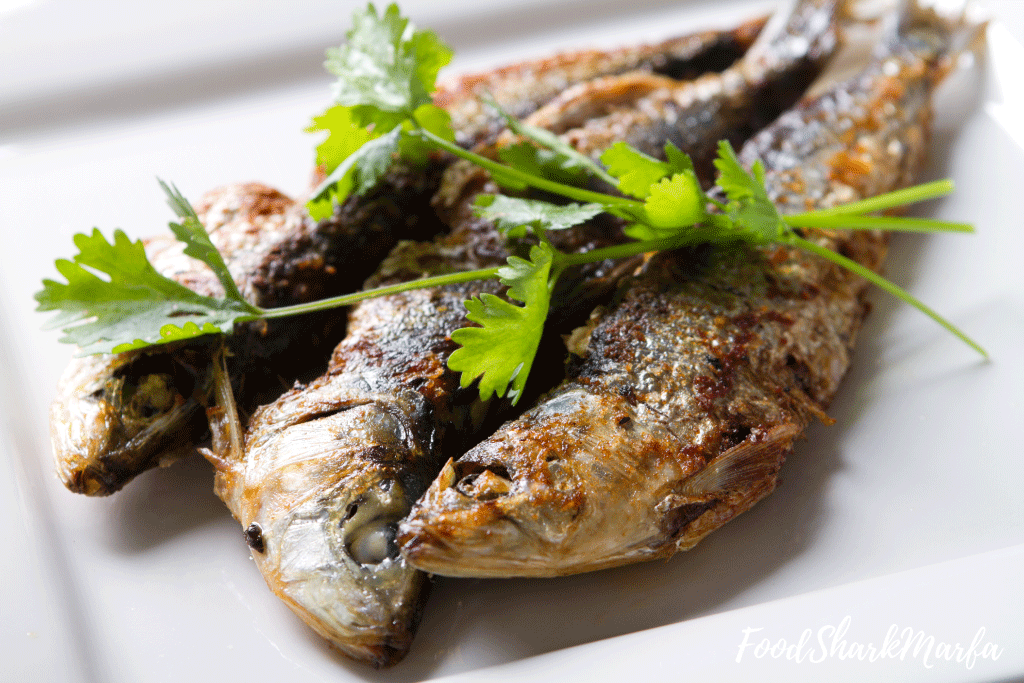
Pasta
You can tip canned sardines in oil straight into the skillet and add them to pasta dishes. As sardines are an oily fish, they suit lemon and tomato-based sauces in pasta recipes. You can even season sardines with chili, coriander and lime for a fusion twist.
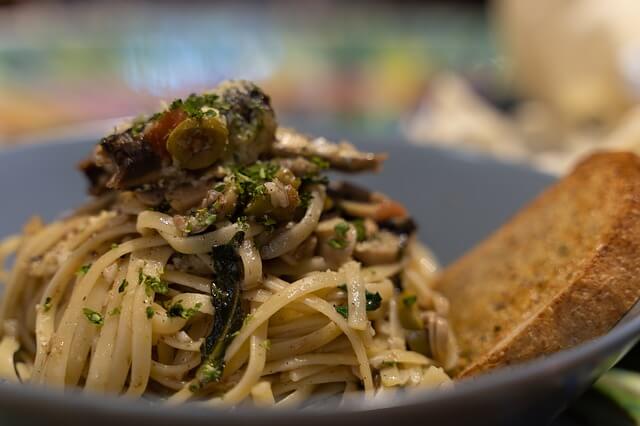
(Source: aanova: Pixabay.com)
Pizzas
Add some extra protein to homemade pizza by cutting up some canned sardines and adding them before putting the pizza into cook. It will also make a change from anchovies!
Curry
Why not try adding some garlic, shallot and tablespoon of Thai red curry paste to some oil in the skillet then add a can of drained sardines. In a few minutes - once the sauce has thickened - just add a little coconut cream and you have an extra quick curry ready to serve!
Straight from The Can
It must be said that this may not be the preferred choice for all, but if you need a protein boost, just eat sardines straight from the can!
Pro Tip: Warm up canned sardines by placing the open can underneath the broiler for a minute or so.
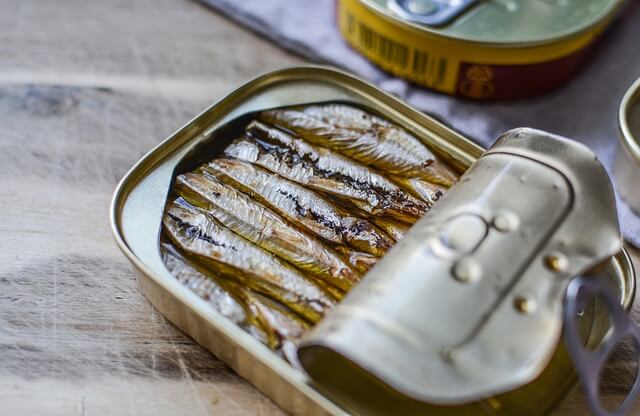
(Source: monicore; Pixabay.com)
Tutorial on How to Make Quick Canned Sardine Spaghetti
I have selected this recipe as you will probably already have all the ingredients in your pantry. It is also very quick and easy to prepare and if you are not as keen on the taste of oily fish then the addition of the garlic and herbs in this dish can help to cut through some of the ‘fishiness’ of the sardines.
What You Will Need to Follow This Tutorial
This will make a quick meal for one; just double the quantities for a meal for two.

Kitchen Tools Needed for Quick Canned Sardine Spaghetti
- Chef’s knife – For cutting the onion with
- Cutting board – To protect the countertop
- Garlic mincer – If you do not have a mincer then crush the clove with the flat of the knife and your hand
- Fry pan/skillet – For frying the sardines and sauce in
- Sauce pan - For cooking the spaghetti in
- Spatula/wooden spoon – The most suitable for your type of pan
- Measuring spoon – For measuring out the herbs
Ingredients for Quick Canned Sardine Spaghetti
- One can of sardines in tomato sauce
Pro tip: You can also use canned sardines in oil or water, but if you do then add ½ can of chopped tomatoes to the pan with the sardines to add the tomato base to the sauce.
- Dried spaghetti (linguine is also fine) or you can use fresh spaghetti if you have some – Around 2 oz of dried spaghetti or the equivalent diameter of a quarter is one portion
- 1 clove of garlic minced or crushed - avoid chopping it unless you can do it very finely as it will only be cooking for a few minutes
- ½ yellow onion
- Pinch of chili flakes
- Pinch of paprika
- ¼ teaspoon dried Italian herbs (mix of oregano, basil, marjoram, rosemary etc.). You can use fresh herbs but as this only cooks for a few minutes, they may not add enough flavor
- Salt and black pepper to taste
- Olive oil – To sauté the onions with
- Fresh lemon juice – Just a squeeze is fine
For the garnish
- Fresh parsley
- A little parmesan or other hard cheese if you like
Step by Step Instructions
Step 1: Start spaghetti cooking and prepare onion: Place your dried spaghetti in the saucepan with water to cook as per the instructions on the packaging. If you are using fresh spaghetti, then do not put it onto cook yet.
Using the cutting board, finely chop your onions ready for sautéing.
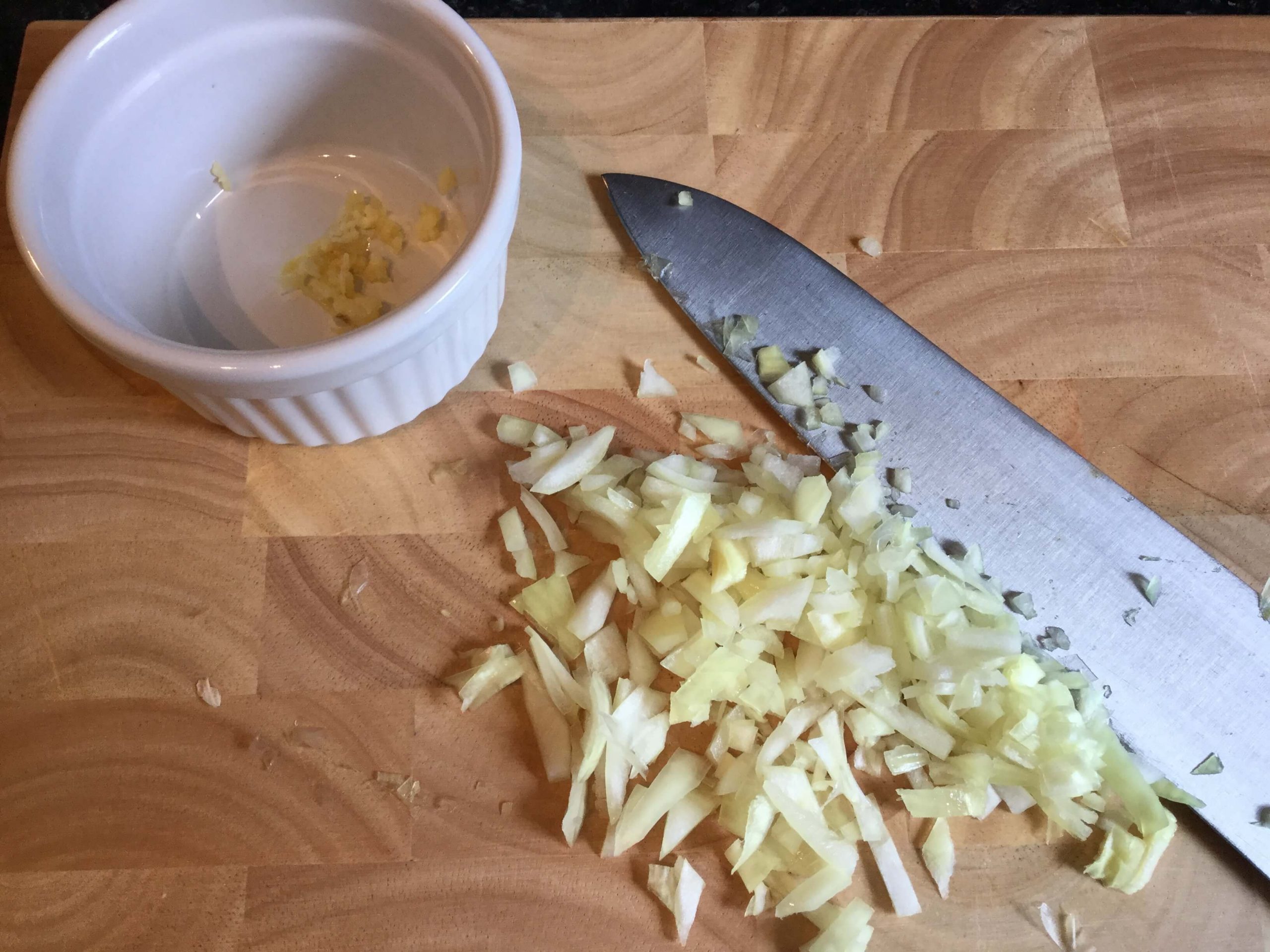
At the same time, place some olive oil into the skillet to heat up. Once the oil is hot enough, add the onions and crushed garlic.
Step 2: Add seasonings: the crushed garlic, chili flakes, herbs, salt and black pepper and stir well to make sure the ingredients are all mixed in and coating the onion.

Stir frequently and cook for two to three minutes until the onions are browned and softened, or as per your preference.
Step 3: Add sardines: If you are using fresh pasta, then put it into hot water to cook now.
Turn down the burner under the fry pan onto low and add the can of sardines to the skillet. Use a spatula to gently break up the sardines and mix well into the onions.
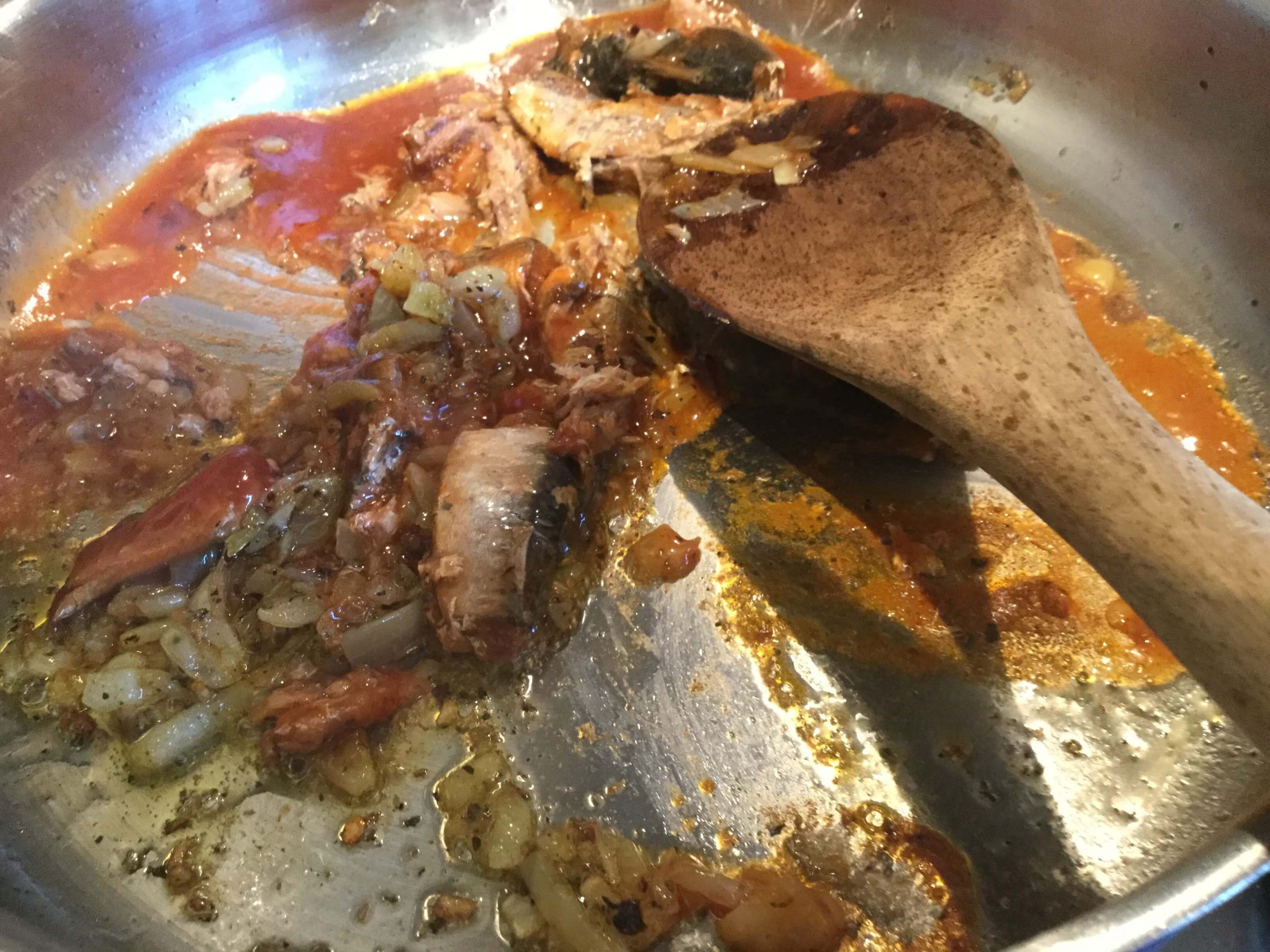
Simmer on low for one to two minutes while stirring. Turn off burner, add dash of lemon juice and stir once more.

Step 4: Serve: Strain spaghetti and add to sardines.
Plate up and garnish with a little fresh parsley and a sprinkling of parmesan or other hard cheese if you wish.

Conclusion
I hope you have enjoyed my step by step tutorial how to eat sardines with a quick canned sardine spaghetti. I do like to cook this occasionally as it is a minimal fuss dish and I usually have all the ingredients to hand.
If you have enjoyed this tutorial and reading about the wide variety of ways that you can eat sardines, then feel free to share it with your friends. Also feel free to add any comments below or share some of your favorite ways to eat sardines.


